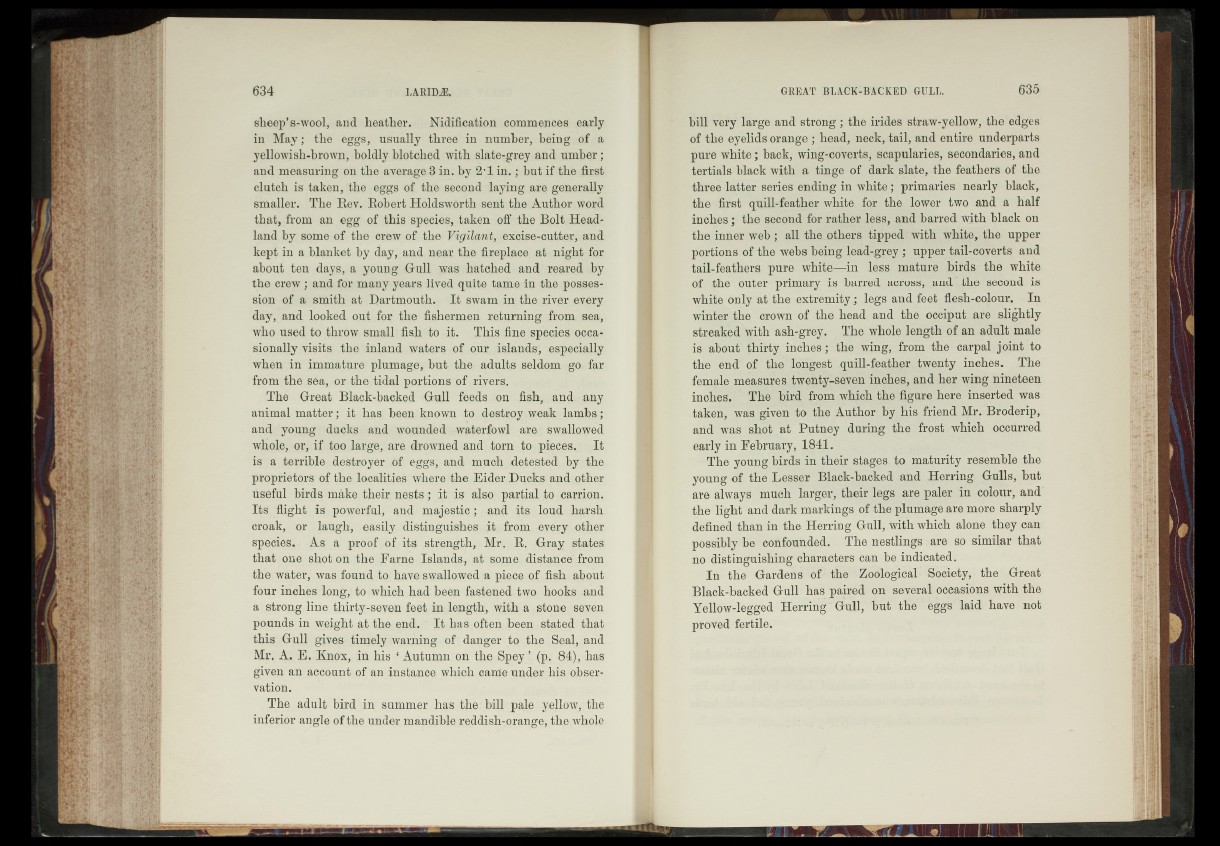
sheep’s-wool, and heather. Nidification commences early
in May; the eggs, usually three in number, b,eing of a
yellowish-hrown, boldly blotched with slate-grey and uniter;
and measuring on the average 3 in. by $ 'l* in .; but if the first
clutch is taken, the eggs of the second laying are generally
smaller. The Rev. Robert Holdswerth sent the Author word
that, from an egg of this 'species*, taken off “the Bolt Headland
by some of the crew of' the Vigilant,:-excise-cutter, and
kept in a blanket by day, and near the fireplace at night for
about ten days, a young G-ull was hatched and, reared* by
the crew; and for many years lived* quite tame in the* possession
of a smith at Dartmouth. It swam in the river every
day, and looked out for the fishermen* returning from sea,
who used to throw small'fish to ;it. This fine species occasionally
visits the inland waters of our islands, especially
when in immature? plumage, but the adults seldom go- far
from the sea, or the tidal portionS/Oft^fyegs. | |
The Great Black-backed Gull feeds: on fish,; and, any
animal matter; jt has been known tUs destroy .weak- lambs;
and - young ducks and wounded -waterfowl are,»' swallowed
whole, or-, ifvtoo large, are* drowned and, torn ,tospi&&cpg,j ■. It
is a terrible;, destroyer .of' eggs,> and much -dqteqted, by: the
proprietors of the localities where *|abe -Elder Ducks andjgthqr
useful birds make their;nestsi .It; is also, partial to carrion.
Its'flight is powerful, and majestic; and its loud harsh,
croak, or laugh*, easily, distinguishes ah-froro. every; ,©4thgr
species,* As a proof .ofjits 'S tr e n g th s ,;R - .Gray spates
that one shot on the Farne Islands, at some distance- from
the water,- was found, to have swallowedja‘pieca,of fish about
four inches long^to /which had beep fastened t^Ojihook^apd
a strong line thirty-seven feet in length, with a stone seven
pounds in weight at the end. ' It has-often been stated that
this Gull gives 5timely washing-ol'dayger- tqothe .-Seal, and
Mr. A. E. Knox,;tin his ‘ Autumn on the ^geyj^ (p,; 84), has
given an accountjjOf an instance which cartfe under his observation.
The adult bird -ihg sunamer has tliQ^bil-I pale yeJ;l;ow,;the
inferior angle of the under mandible reddish-orange^th^fwhole
bill very large and strong ; the hides straw-yellow, the edges
of the eyelids orange ; head, neck, tail, and entire underparts
pure white; back, wing-coverts, scapularies, secondaries, and
tertials black with a tinge of dark slate, the feathers of the
three latter series ending in white);' primaries nearly black,
the first quill-feather white for the lower two and a half
inches; the second for rather less, and barred with black on
the inner web ; all the.others tipped* with white,-the upper
portions of the webs being lead-grey ; upper tail-coverts and
tail-feathers pure wh^^-mT^lèss mature birds the white
of the outer primary is barred' across, \and) the "second is
white only at the~extremity^, legs and féét flesh-colour. In
winter-the crown of the head and the occiput^re slightly
streaked with ash-grey. The whole length of an adult male
î | about- thil-ty inches-.; the wing, from the carpal joint to
the end" of the - longest quill-feather twenty inches. The
female measures twepty-seven inches, and her wing nineteen
inchest * The bird from which, the'figure here inserted was
taken, was given to the Author- by, his friend Mr. Broderip,
and was shpV at Putney during the frost which occurred
early in February, 1841. -
The Wùpg birds in their stages to maturity resemble the
young of the Les'sgr ,Black-backed and Herring Gulls, but
are always much larger, their legs are paler in colour, and
the light' and dark markings of?ffie plumage are more sharply
defined than in the Herring Gtrïl, With which alone they can.
possïbïÿ$%é confounded. The, nestiings ;-are so similar that
ire distinguishing characters- can fbe?indicated.
In the“' Gardens ôfHhe^îbelé^cal^êoèiety, the; Great-
Black-backed Gull has paired on several occasions with the
Yellow-legged Herrinf^Gull, but the’^efjgb laid have^*@|:
proved fertile.